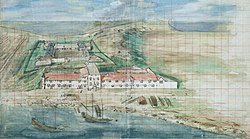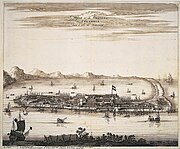
Overview of Fort Zeelandia in Tainan, Taiwan, painted around 1635 (The Hague National Bureau of Archives, Netherlands)

17th century print of Fort Zeelandia

Fort Anping in 2008

Fort Zeelandia (Chinese: 熱蘭遮城; pinyin: rèlánzhē chéng; Pe̍h-ōe-jī: Ji̍at-lân-jia Siâⁿ) was a fortress built over ten years from 1624 to 1634 by the Dutch Verenigde Oostindische Compagnie, in the town of Anping (Tainan) on the island of Formosa (present-day Taiwan), during their 38-year rule over the western part of that island. Although the site was previously named Orange City (奧倫治城), Anping City (安平城), and Taiwan City (台灣城), the current name of the site in Chinese is Anping Fort (安平古堡).
During the seventeenth century, when Europeans from many countries sailed to Asia to develop trade, Formosa became one of East Asia's most important transit sites, and Fort Zeelandia an international business center. On behalf of the Dutch East India Company, ships departed from Formosa and headed north to Japan, west to Fujian, or south to Vietnam, Thailand, Indonesia, India, Iran or Europe.
Strategic location[]
The Dutch chose a sandy peninsula off the coast of Tainan for the fortress, since this would allow direct access to the sea and with it, supplies and reinforcements from Batavia in event of a siege. Unfortunately, the site lacked adequate supplies of fresh water, which had to be shipped from the mainland.
A series of sandbars extended from south to north; the east side of such sandbars was the Taijian Inner Sea. Fort Zeelandia was established on the largest sandbar to control the channel for entering the inner sea. The Taijian Inner Sea was also a good harbor.
Bricks were brought from Java and the mortar consisted of a mixture of sugar, sand, ground seashells and glutinous rice. The fort was designed to be surrounded by three concentric layers of walls and its four corners were built into protruding bastions for better defense.
Dutch bond was used for laying bricks to build Fort Zeelandia. It is created by alternately laying headers and stretchers in a single course to avoid gaps. The next course is laid so that a header lies in the middle of the stretcher in the course below. The Dutch bricks should have a 10-days kilning, the texture is solid and compact, and its color is red.
There were three layers of wall, and a protruding bastion on each of four corners on Fort Zeelandia, in order to expand the defense scope; this is the typical European fort of the 17th century. Inside the fort was the military and administration center, church, garrisons, and jailhouse; outside was the downtown. Between the fort and downtown, there were market, slaughterhouse, gallows, execution ground and city weighing station.
Defensive function[]
Fort Zeelandia included an “inner fort” and an “outer fort”. The inner fort was a square and 3-layer construction. The lowest was for storage of ammunition and food. The second features a blank wall. The middle part of each side has a semicircle protruding barrack to strengthen the defense. Above the third story was the administrative center, including offices, garrison and church, all of them independent structures. There were walls on the periphery, with protruding bastion on each of the four corners, armed with cannons; a watch tower was set at the southwest bastion. The one-story outer fort was a rectangular fort, with bastions on the northwest and southwest corners, armed with several cannons. Inside the outer fort were residences, hospital and houses; the plaza was the commercial area.
Dutch surrender[]
On 30 April 1661, General Zheng Chenggong ("Koxinga") of Ming China (1368-1644) laid siege to the fortress (defended by 2,000 Dutch soldiers) with 400 warships and 25,000 men. After nine months and the loss of 1,600 Dutch lives, the Dutch surrendered on 1 February 1662, when it became clear that no reinforcements were forthcoming from Batavia (present day Jakarta, Java, Indonesia) and when the defenders ran short of fresh water.
Under the Koxinga-Dutch Treaty (1662)[1] signed on 1 February between Koxinga and Frederick Coyett, the Dutch governor, the Dutch surrendered the Fortress and left all goods and VOC property behind. In return, all officials, soldiers and civilians were free to leave with their personal belongings and supplies. On 9 February, Frederick Coyett officially surrendered the fort and led the remaining Dutch forces and civilians back to Batavia by sea, ending 38 years of Dutch colonial rule on Taiwan.
See also[]
- List of museums in Taiwan
References[]
External links[]
| Wikimedia Commons has media related to Fort Zeelandia, Taiwan. |
- Old print of Fort Zeelandia, Amsterdam 1675 (high resolution zoomable scan)
| |||||
Coordinates: 23°00′06″N 120°09′39″E / 23.001747°N 120.160919°E
The original article can be found at Fort Zeelandia (Taiwan) and the edit history here.



